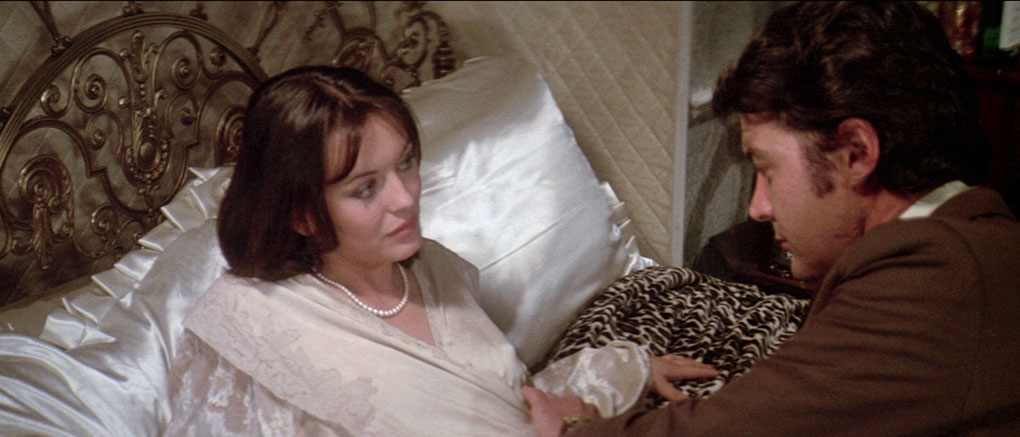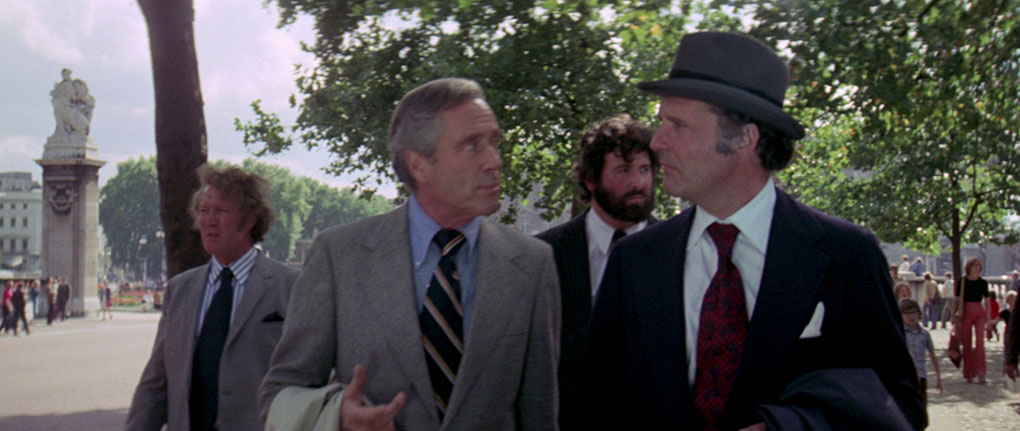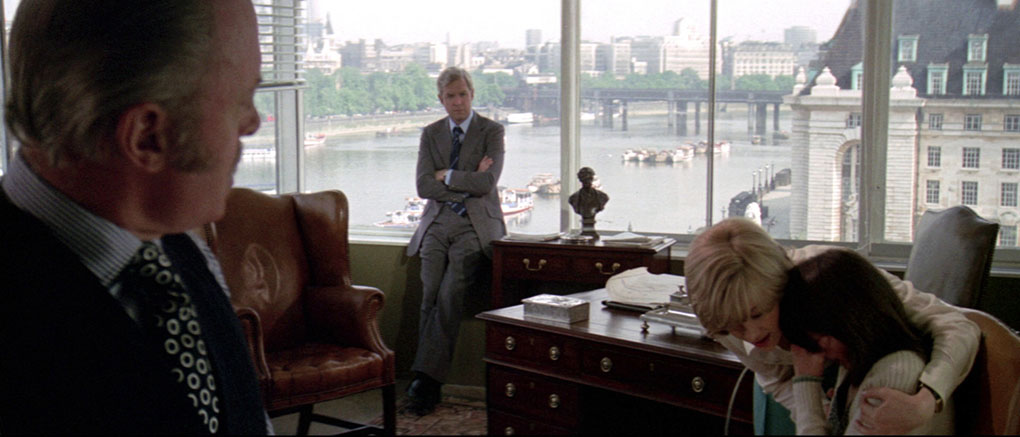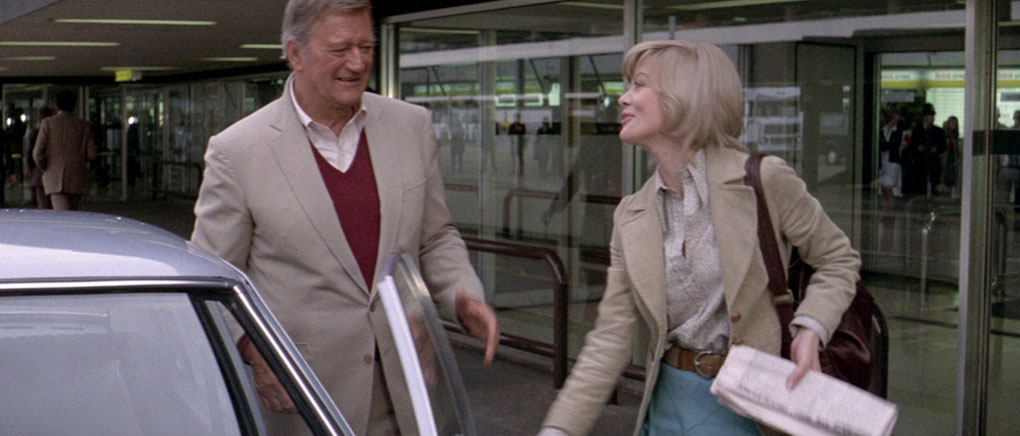|
Jim Brannigan (John Wayne) is a Chicago cop. He’s sent to London to help extradite an American gangster, Ben Larkin (John Vernon). Arrived in the British capital, he works for Commander Charles Swann (Richard Attenborough) and is teamed with Detective Sergeant Jennifer Thatcher (Judy Geeson). Then Larkin is kidnapped by mobsters led by lawyer Mel Fields (Mel Ferrer) and at the same time, Brannigan has a contract out on him.
Forty-four years after his death, it may be hard to realise how big a star John Wayne was. The films which have attained classic status continue to be shown and to be released on home media – such as The Searchers, directed by his frequent collaborator John Ford, and a fixture of all-time-best lists. (In Sight & Sound’s 2023 poll, it was at number fifteen, having been in the top ten in three of the previous four polls.) However, you could argue that this and films like them are watched as classics, not as much as John Wayne films. Part of that may be a reaction to Wayne’s very reactionary politics, though almost everyone who worked with him seemed to have not a bad word to say about him. Yet, in the 1970s he was still pulling them in to cinemas and was ubiquitous on television. Here in the UK, the BBC regularly showed seasons of his films, several of them titled Wayne in Action.
There’s an argument that most film stars – as opposed to character actors who get to play leading roles – give performances based on a particular persona. There may be some changes of appearance and costume but the basic template is always present, with each film playing subtle variations on it. In the present film, Wayne is a Chicago cop, playing a present-day policeman for the second and final time. (The other example was his previous film, McQ, in which he was based in Seattle.) However, Wayne had attained his stardom in the western genre, and this cop movie was, like not a few others, not far off from a western in contemporary dress. Wayne plays a figure that was and still is a perennial in Hollywood films, a cop who doesn’t (quite) play by the rules, both establishment and anti-establishment at the same time...though Brannigan has far fewer shades of grey than Clint Eastwood’s Harry Callahan or indeed Gene Hackman’s Eddie Egan in The French Connection.

Wayne had begun his career in the silent era, and 1975 American cinema was in the midst of what’s now known as The New Hollywood. A new generation was making waves, and many of the films turning up at your cinema in those pre-multiplex days reflected this: darker, grittier, more cynical, less beholden to old and increasingly outmoded social certainties. They also benefited from the breakdown of film censorship and the abandonment of the Production Code, which had held sway since the mid-1930s, in favour of a ratings system. The western, the genre where Wayne had made his name, had been changed in the 1960s by foreign productions such as Sergio Leone’s Dollars trilogy and at home by the likes of Sam Peckinpah’s unsparingly violent elegy for the old West, The Wild Bunch. Brannigan is very much a film of the old school, and with a few tweaks and tonings-down could have been made a decade earlier. However, it can’t help but reflect what was happening with the major studios. Wayne had been offered Dirty Harry but had declined it, later regretting it. (Frank Sinatra had been offered the role before him, and Wayne’s pride didn’t allow him to pick up Sinatra’s discards.) However, there are more than a few overtones of the Eastwood film in McQ. Brannigan in its own way has shades of another Eastwood film with a fish-out-of-water theme, Coogan’s Bluff.
When he made Brannigan, Wayne was in his late sixties, playing a man at least a decade and a half younger. He wasn’t a well man, having lost a lung to cancer a decade earlier. He had heart problems and had recently had a bout of pneumonia. Yet that’s hard to detect in this film, where he gives a relaxed performance and gets to enter the film by knocking a door down (“Knock knock”), a gag which gets a payoff at the end. He plays well off a strong supporting cast, headed by Richard Attenborough (who at 5’6½” was too short to be a policeman then, but never mind), who is not as far to the dark side as some of his roles had been (Brighton Rock and 10 Rillington Place, for example) but has more of an edge than usual. He’s clearly enjoying himself and in the extensive bar-fight scene even gets to slug The Duke. The third lead is Judy Geeson as Brannigan’s minder from the Met, and she gets to be resourceful and has more to her role than screaming, crying and having to be rescued. Her character’s relationship with Brannigan gets to remain platonic, not just because of the age difference between them, but because she has a fiancé and he presumably has a family back home, with a son being mentioned. The villains are less vivid, though Daniel Pilon makes an impression as a sadistic hitman. Below them are a plethora of mainly British character actors, many of them familiar faces on television, such as Lesley-Anne Down, at the time a star on the small screen in Upstairs Downstairs, as a call girl. Tony Robinson’s role, as a motorcycle courier who gets thrown by Brannigan into the Thames, turned up in the old BBC series Before They Were Famous, in which Angus Deayton got to be snide about celebrities in early roles, including to be fair himself.
Brannigan was the work of four credited writers: Christopher Trumbo, Michael Butler, William P. McGivern and William Norton, the first two given story credits as well. The first-named was the son of Dalton Trumbo, who had been blacklisted during the McCarthy era, but he was reported as saying that he had no issues with writing a film for Wayne, though their politics likely had few if any overlaps. British director Douglas Hickox’s work is the model of efficiency, and gains by some excellent use of London locations, not just the usual tourist spots, including parts of the city which are no longer in the same form nowadays, such as the later-to-be-redeveloped Docklands area. One of them is Beckton Gas Works, which twelve years later stood in for Hué, Vietnam, in Full Metal Jacket and is now an industrial estate. There is some unique footage shot inside the Garrick Club, an institution which normally doesn’t allow filming inside but relented this time due to Attenborough being a member. We know we’re in London because over the first shot of the city, Dominic Frontiere’s score breaks into “Rule, Britannia”.

Brannigan wasn’t a particular success. McQ hadn’t been either, suggesting that the New Hollywood tide was turning against Wayne, or that the public didn’t especially want to see him in modern-day cop roles, or both. However, the film has always had its defenders, one of them being Quentin Tarantino. Wayne would make just three more films, going out in 1976 with one of his best performances, as a cowboy dying with cancer (as Wayne was) in The Shootist. John Wayne died in 1979.
Brannigan is a Region B Blu-ray release from the BFI. The film itself was given a surprisingly lenient A certificate (the equivalent of a modern PG) in cinemas but has on three occasions been passed 15 for home viewing. The reason is “infrequent strong violence”, namely some blood spurts towards the end, and strongly implied sexual threat in Lesley-Anne Down’s scene. Whether this film will have much appeal to the young is a moot point – Wayne’s fanbase at the time, with many of his films relatively family-friendly, has inevitably aged.
The film was shot in 35mm with anamorphic Panavision lenses and the Blu-ray transfer is in the intended ratio of 2.35:1. The transfer is based on a HD master supplied by MGM, and certainly looks like what an anamorphically-shot feature from the time would have looked like – a little soft in longer shots with shallower depth of field compared to films shot with spherical lenses – but that’s inherent in the way the film would have been shot. The film isn’t anywhere near as dark as other cop thrillers of the time were – for example, those shot by Bruce Surtees for Clint Eastwood – which gives it more of an old-school look, more Sixties than Seventies. Grain is natural and filmlike. I’m not in any doubt this looks pretty much like it would have done if you’d seen a new print on or near to first release, or as much as HD digital can compared to photochemical 35mm.
The soundtrack is the original mono, rendered as LPCM 2.0. This is a work of Hollywood/British professionalism, with dialogue, sound effects and Frontiere’s score clear and well-balanced. There are English subtitles for the hard-of-hearing available on the main feature but not any of the extras.
Commentary by Steve Mitchell and Nathaniel Thompson
Carried over from Kino Lorber’s 2017 Blu-ray, this pairs Mondo Digital critic Thompson and filmmaker Mitchell, whose documentary King Cohen (on Larry Cohen) was current at the time of recording. Both men think that Brannigan has “aged well” as Mitchell puts it. This is a thorough go-through of the film, covering most bases and without too much spending time on filmographies clearly lifted from the IMDB. They both spend time remarking on the London locations, and particularly Douglas Hickox and cinematographer Gerry Fisher’s eye for shooting them in Scope, something they hadn’t often associated the city with. Nor, for that matter, was colour, though obviously in 1975 virtually every major-studio release was not in black and white. There’s a good rapport between the two, and this is an entertaining and informative commentary.
The Guardian Interview: Richard Attenborough (88:06)
This was recorded at the National Film Theatre, London (now the BFI Southbank), on 15 February 1983, with Attenborough interviewed by David Castell, then film critic of the Sunday Telegraph and who would go on to write a biography of the man. Brannigan doesn’t get a mention at all, as this is a career overview and the big news then was Gandhi, released in British cinemas two months earlier and two months away from winning its eight Oscars. Attenborough’s well-established reputation for luvviness is well in evidence, as he refers to (Bryan) “Forbesie”, “Jimmy” Mason and so on. Having seen Attenborough interviewed (a later one, following a preview of Shadowlands) at this venue myself , I can vouch for this. As Castell says at the start, there’s hardly a pie that Attenborough didn’t have his fingers or whole hand in. Inevitably, Gandhi takes up much of the discussion, with Attenborough talking about the long process of getting the film made, including some of the suggestions for actors to play the title role. Several of them were white British actors, on the grounds of their being more commercial than Indian ones. While the film was in development, with Attenborough having to finance trips to India for him and key crew-members, he took acting roles to help pay for this. At one point, with Attenborough having to face the possibility of giving the film to someone else to direct, it was suggested that Attenborough play Gandhi himself. Fortunately that didn’t happen. Attenborough does talk about his preferences for the films he liked to make: not total escapism and not anything with gratuitous violence, with some element of social comment. He talks about the biopic of Tom Paine he wanted to make but in the event he never did.

After a couple of clips from his performances, from Brighton Rock and Seance on a Wet Afternoon (as usual, edited out of this recording), Attenborough answers questions from the audience, not all of which are easily audible despite the presence of a roving microphone. This recording is presented as an alternative audio track for the feature, and is replaced by the film audio once it finishes. This interview is preceded by a caption advising of racist language, which in this case is in the context of a discussion of Agatha Christie adaptations (Attenborough and his wife Sheila Sim were for a time in the cast of the world’s longest-running stage play, The Mousetrap), as Castell refers to the original title of her novel And Then There Were None.
A Duke Out of Water (37:16)
A newly-made making-of featurette. There’s only one member of the cast interviewed, Stewart Bevan, with the others being crew members you don’t often hear from and in some cases aren’t credited on the film. So we have Emma Porteous (costume designer), Jan Dorman (hairdresser), Bill Westley (second assistant director) and three stuntmen, Dinny Powell, Steve Emerson and Chris Webb. Everyone is interviewed separately and intercut so at times they appear to be commenting on each other’s words. Given the number of stuntmen involved, there’s a lot of discussion of the pub fight, and Bevan talks about the Tower Bridge stunt. Another recurring theme is how much Wayne was liked, with Westley being the one exception. The featurette is dedicated to the memories of Stewart Bevan and Dinny Powell, who passed away in 2022 and 2023 respectively, in the latter case only two months before this disc’s release.
Frank Henson on Brannigan (4:19)
A separately made piece from 2021, an interview with another of the stuntmen. This is quite short and inevitably overlaps with the contributions of the three stuntmen in the previous featurette.
Take It to the Bridge
The BFI often include extras on their releases from their archive which aren’t anything to do with the main feature but are tangential to an aspect of it. As a key setpiece in Brannigan involves Tower Bridge, here are four short films involving the iconic London landmark, with a Play All option.
Tower Bridge Boats on Thames (2:09)
From 1905, much of this is a slow panning shot from the riverbank, starting at London Bridge (with a lot of horsedrawn traffic crossing). A couple of cuts later, we are on Tower Bridge and watch the bridge being raised. This is presumably edited from a longer film as (on the review checkdisc at least) it ends with an intertitle, “Hyde Park Corner”. Maybe that part is on another BFI release.
London River (3:39)
Made in 1930, silent and made for the 16mm home cinema market, and very soft and grainy it is. Although it does leave the river sometimes, for Limehouse and Covent Garden market, it mostly follows the river nearly to the sea.
Tower Bridge Road Market (4:54)
This is from 1931, also silent. This isn’t as much to do with the bridge itself but the road leading up to it, and the market held there with plenty of people present. Intertitles identify some local landmarks, including pubs which are no longer there and a few shops which are. They also helpfully advise that rabbits then would set you back nine old pence per pound.
Central London Traffic (11:30)
On to 1956, and in colour 16mm (also soft and grainy) with a narration, made by the Road Research Laboratory Film Unit. It looks like driving in the capital nearly sixty years ago was a fraught experience, with a Rentokil van turning round in Oxford Street, a horsedrawn dray causing a hold-up on Tower Bridge and traffic congestion in Soho Square.

A Policeman’s Lot
On a cop movie, some more cop movies as extras, also with a Play All option.
Footpads (0:35)
A mugging on a rainy night in Ludgate Circus in 1895, with a vintage advertising hoarding for Bovril in the background, actually a painted backdrop. A single shot, one of the earliest British crime films, this has been attributed to Robert W. Paul and photographed by fellow pioneer Birt Acres, but this hasn’t been proven conclusively.
Clown and Police (1:50)
After all that rough stuff, this film from 1900 is much more of a flight of fancy, the work of another British pioneering filmmaker, Cecil Hepworth. A tramp, a clown and a policeman and an exploding gunpowder barrel with plenty of camera tricks so that characters and objects appear and disappear at will.
Home Beat Policeman (7:10)
After that, this is positively cosy, which was no doubt the intention. Beat bobby Jim Yates takes us on his rounds in Notting Hill in 1973.
Your Police...and You (25:46)
Also from 1973, this documentary was commissioned by the Met, hoping to address the public’s respect for them, or lack thereof. We watch policemen and women in action. Statistics are presented and scenes are reconstructed, some of them surprisingly graphic, considering this might well have been shown in schools.
Image gallery (12:13)
A self-navigating collection of stills and some lobby cards, some in colour but many in black and white.
Trailer (2:22)
A pacy trailer, which effectively sells the film as a Wayne picture and an action piece. It’s noticeable for a little bit of censorship, for ratings reasons perhaps, as the line “big Irish bastard” gets the final word blanked out on the soundtrack. Lipreaders, prepare to be offended.
Booklet
The BFI’s booklet, available in the first pressing only, runs to twenty pages. It’s worth mentioning that this is the sole source in the release of details of the short films among the extras.
It begins with “‘So Damn Solid’”, which is how Jennifer refers to Brannigan at one point. Johnny Mains starts by mentioning Wayne’s almost-casting as Dirty Harry before mentioning how Wayne’s two cop films do follow Eastwood’s example. He also places Brannigan as part of the cycle of gritty British crime films, though a far more family-friendly example compared to, say, Hickox’s own film Sitting Target. He details that Wayne was paid far more than anyone else, including a 10% gross profit share once the film passed $7.5 million (which it never did). Wayne’s star was such that the usually reluctant Chicago authorities were persuaded to let the production film the opening scenes there. Wayne was very ill, often requiring oxygen on set. With the film’s lack of success, he returned to westerns, but only had another four years to live.
Next up, John Oliver provides “John Wayne: A Monolith of Survival”, a four-page biography of the man, the title coming from David Thomson’s phrase. The booklet also contains full film credits and notes on and credits for the extras.
Brannigan is part of the last few years of John Wayne’s career, in which he tried to keep up with the times by making cop movies rather than the westerns which had made his name. Undoubtedly too old, though not betraying on screen how ill he was, Wayne leads a lively thriller with a good eye for its London setting, the kind of entertaining star vehicle that you would happily make a trip out to your local cinema for, nearly half a century ago. It’s presented well by the BFI for this Blu-ray release.
|